Last Updated on 3 months by Sachin G
In this tutorial, i am going to install Beanstalk on CentOS, Alma Linux, Fedora, and Red Hat Server. Beanstalk efficiently manages background jobs, which is crucial for web applications with high traffic or real-time operations. The article provides step-by-step instructions for the installation process on RPM-based Linux distributions.
Beanstalk managing background jobs efficiently and is very important for many web applications, those with high traffic or real-time operations. Beanstalk, a simple and fast work queue .it makes programmers or developers to offload the tasks from their main application.speeding up user interactions by handling long-running processes in the background.
I have faced unavailability of the beanstalk package in the EPEL yum repository, but I found that in Fedora repository, the package is available. So you can either choose source code build solution from githhub.io or download an RPM from cbs.centos.org .
Prerequisites
Before diving into the installation, ensure that you have the following prerequisites:
- A System running CentOS , RHEL , or Fedora.
- Root or sudo access to the server.
Their is two different process for different Operating System.Please choose according to you need.
Fetch Information and Install Beanstalk on Fedora
With the Fedora official repository install Beanstalk. Use the following commands to check information about beanstalkd and install it.
sudo yum info beanstalkd -y
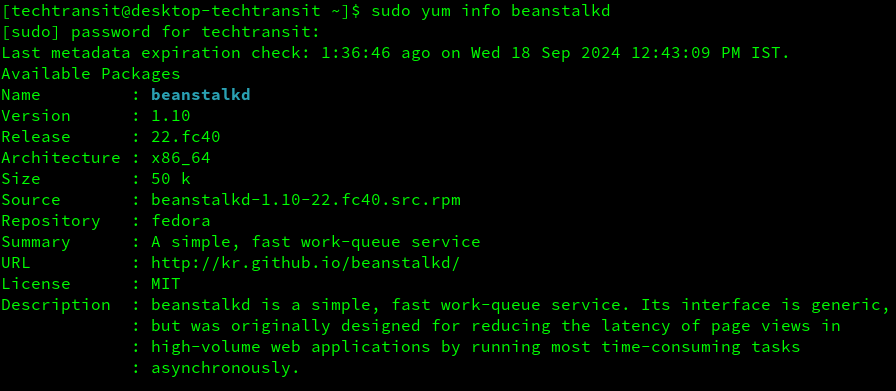
By the above command information about beanstalkd package.
sudo yum install beanstalkd -y
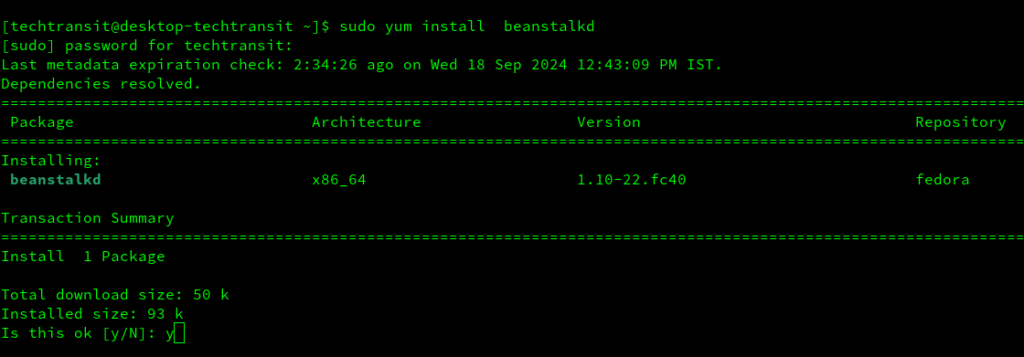
Once the installation is done from above command , you can verify it by checking the version or confirming its presence on your system :
beanstalkd -v
Start and Enable Beanstalk Service
After configuring Beanstalk, the next step is to start the service and ensure it runs whenever the server reboots.
To start and enable to start at boot the service, use the command below :
# sudo systemctl start beanstalkd
# sudo systemctl enable beanstalkd
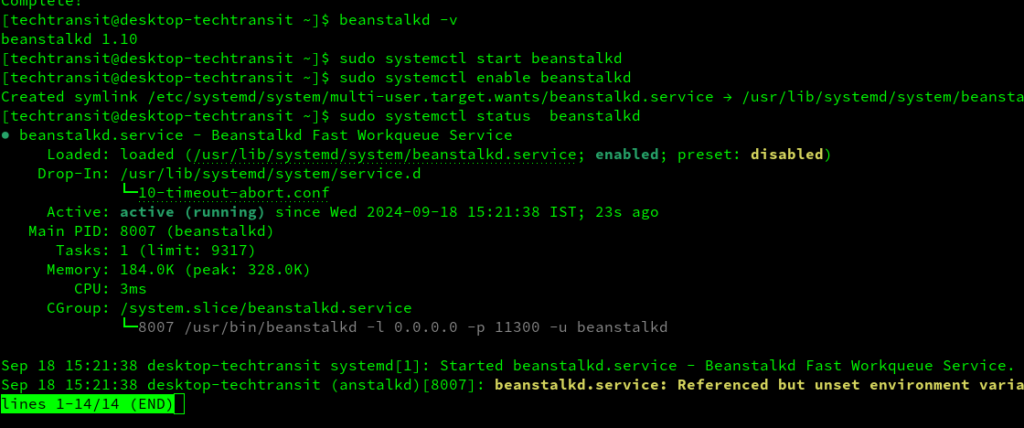
Install Beanstalk on Alma, CentOS, Red Hat ( RHEL ) Linux
In other RPM-based Linux distributions, the EPEL repository doesn’t include this package. So, I downloaded the Beanstalkd and Beanstalkd-debuginfo RPMs directly from cbs.centos.org using the wget command, as shown below.
Download the beanstalkd RPM
# wget https://cbs.centos.org/kojifiles/packages/beanstalkd/1.10/15.el9/x86_64/beanstalkd-1.10-15.el9.x86_64.rpm
If you want to debug any application then you need to install debug package This package provides debug information for package beanstalkd, below are download command for beanstalkd-debuginfo .
# wget https://cbs.centos.org/kojifiles/packages/beanstalkd/1.10/15.el9/x86_64/beanstalkd-debuginfo-1.10-15.el9.x86_64.rpm
Install Beanstalk
Use below command to install packages.
# rpm -ivh beanstalkd-1.10-1.el7.x86_64.rpm
OutPut
[root@techtransit]# rpm -ivh beanstalkd-1.10-15.el9.x86_64.rpm
Verifying… ################################# [100%]
Preparing… ################################# [100%]
Updating / installing…
1:beanstalkd-1.10-15.el9 ################################# [100%]
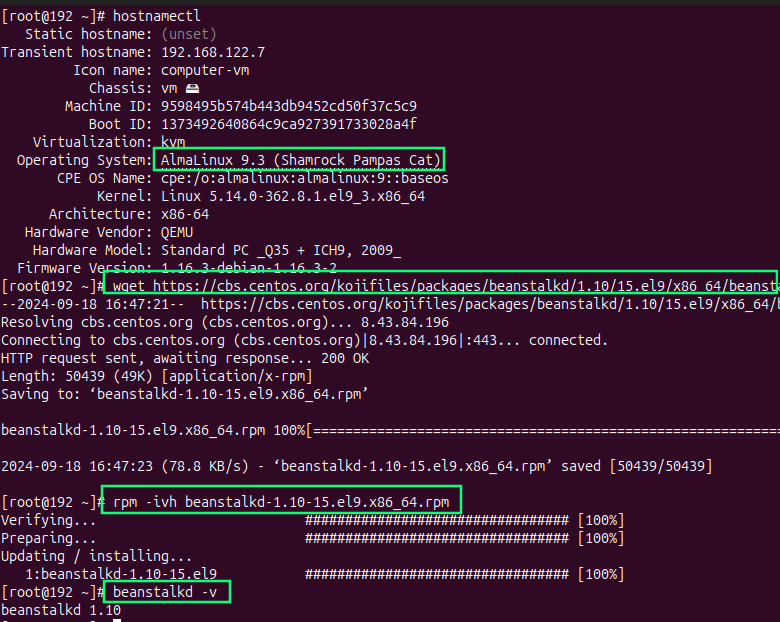
After the installation, you can verify the version using the previously mentioned command beanstalkd -v, which is also displayed in the screenshot. Now, you can start and enable the service. Refer to the commands in the section above on starting and enabling the service.
Verify Services Status
Run below command to check process is running.
# ps aux | grep beanstalkd
# systemctl status beanstalkd
OUTPUT: [root@192 ~]# ps aux | grep beanstalkd
beansta+ 11965 0.0 0.2 2832 1980 ? Ss 17:31 0:00 /usr/bin/beanstalkd -l 0.0.0.0 -p 11300 -u beanstalkd
root 11996 0.0 0.2 3876 2008 pts/0 S+ 17:32 0:00 grep –color=auto beanstalkd
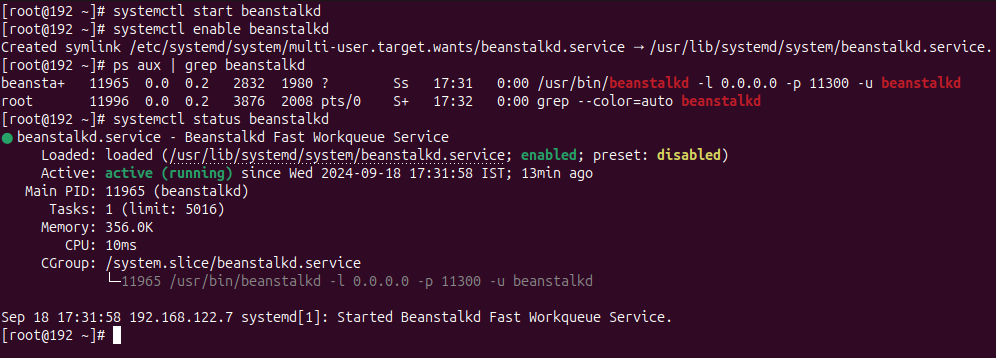
Alternative is Redis or RabbitMQ but beanstalkd is simple and efficient solution compared to others.its speed and simplicity make it ideal for smaller projects or situations where performance is key.

I’m Sachin Gupta — a freelance IT support specialist and founder of Tech Transit. I’m certified in Linux, Ansible, OpenShift (Red Hat), cPanel, and ITIL, with over 15 years of hands-on experience. I create beginner-friendly Linux tutorials, help with Ansible automation, and offer IT support on platforms like Upwork, Freelancer, and PeoplePerHour. Follow Tech Transit for practical tips, hosting guides, and real-world Linux expertise!
